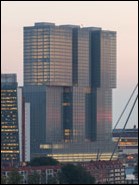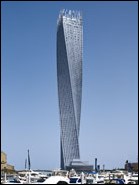by Brianna Crandall — July 14, 2014—Four buildings, from the United States, Australia, the Netherlands and the United Arab Emirates, have been named the best tall buildings in the world for 2014 by the Council on Tall Buildings and Urban Habitat (CTBUH), the Chicago-based, not-for-profit global resource for professionals focused on the design, construction, and operation of tall buildings and future cities.
The CTBUH Annual Awards for the Best Tall Building are an independent review of new projects, judged by a panel of industry experts. Projects are recognized for making an extraordinary contribution to the advancement of tall buildings and the urban environment, and for achieving sustainability at the broadest level. The judges’ observations from this year include:
- Many projects show strong sustainability commitment, including greenery at height
- Many older buildings are being re-energized by thoughtful renovations
- Eccentric shapes, new programs and uses (such as higher education) challenge traditional perceptions of tall buildings
The four regional winners and the finalists for Best Tall Building are:

AMERICAS
- Winner—The Edith Green-Wendell Wyatt Federal Building, Portland, USA: a renovation of an existing 1970s office tower into a high-performing, attractive building that seems more lightweight yet affords more floor space
- Finalist—The Point, Guayaquil, Ecuador
- Finalist—United Nations Secretariat Building, New York, USA
ASIA AND AUSTRALIA
- Winner—One Central Park, Sydney, Australia: residential building that uses two unusual technologies for tall buildings—hydroponics and heliostats—to grow plants around the periphery of the building at all levels
- Finalist—8 Chifley, Sydney, Australia
- Finalist—Abeno Harukas, Osaka, Japan
- Finalist—Ardmore Residence, Singapore
- Finalist—FKI Tower, Seoul, South Korea
- Finalist—Ideo Morph 38, Bangkok, Thailand
- Finalist—Sheraton Huzhou Hot Spring Resort, Huzhou, China
- Finalist—The Interlace, Singapore
- Finalist—The Jockey Club Innovation Tower, Hong Kong, China
- Finalist—Wangjing SOHO, Beijing, China

EUROPE
- Winner—De Rotterdam, Rotterdam, Netherlands: De Rotterdam, Rotterdam, Netherlands: the largest building in the Netherlands, its mass is broken down into three interconnected mixed-use towers
- Finalist—DC Tower, Vienna, Austria
- Finalist—NEO Bankside, London, UK
MIDDLE EAST AND AFRICA
- Winner—Cayan Tower, Dubai, UAE: a 75-story luxury apartment building with a striking helical shape, turning 90 degrees over the course of its 304-meter height, with each floor identical in plan, but set 1.2 degrees clockwise from the floor below

An overall winner for the “Best Tall Building Worldwide” will be named from the four regional winners at the CTBUH 13th Annual Awards Symposium, which will take place in Chicago on November 6. CTBUH’s 10-Year, Urban Habitat, Lifetime Achievement, Building Performance and Innovation awards will be announced in the coming weeks, and will also feature at November’s awards events.
The Council received 88 entries from around the world for the Best Tall Building awards. The largest number of entries was from Asia, with a significant number also from Europe. Winners and finalists are featured in the annual CTBUH Awards Book, which is published in conjunction with a major global publisher and distributed internationally each year.
“The submissions this year reflect the incredible diversity of tall buildings being built around the world,” said Jeanne Gang, awards jury chair and founding principal of Studio Gang Architects. “Even more so, they reflect the dawning of a global recognition that tall buildings have a critical role to play in a rapidly changing climate and urban environment.”





